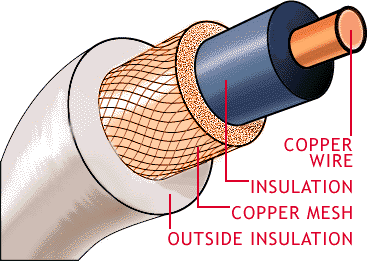
How To Select Feedline For A Repeater, By Todd, KY4TS
By Todd, KY4TS
A common overlooked part of putting together a repeater system is the selection
of proper feedline. "But, coax is coax, isn't it?" "I use LMR-400 for all my stations at home. That should be good enough for a repeater, right?" Well, not necessarily.

“In duplex service you want to avoid any coax that has dissimilar metals rubbing against each other (such as Belden 9913) or any LMR-(any 3-digit or 4-digit number) cable since both use an aluminum foil shield rubbing against a copper braid (and they are not the only ones with that type of construction).
In a coax cable, any dissimilar metals in contact with each other are bad news. Aluminum oxide is formed when raw aluminum is in contact with oxygen, and the chemical reaction that converts the top few molecules of the exposed surface of aluminum into aluminum oxide is almost instantaneous.
Aluminum oxide makes a dandy diode. All those millions of contact points between the copper braid and the aluminum oxide layer on the aluminum foil become millions of little tiny diodes. In the presence of high RF power levels all those little diodes cause RF noise. The amount of noise energy on any one frequency (such as on your repeater input frequency) is a low level, but when you have the noise source inside the same feedline that feeds a sensitive receiver it doesn’t take much level to be audible.
I repeat – any cable that has dissimilar metals pressed together, even inside a jacket, will sooner or later create wideband noise (sometimes called duplex grunge) when hit with RF power. Even something as simple as a 1-foot-long jumper between the feedline and the antenna at the top of the tower can cause major desense problems (and for a long time the major antenna manufacturers were shipping 9913 jumpers with their antennas). 9913 is usable in an indoor simplex environment, but you will find that 9913 or any dissimilar metals cable, especially LMR-(any 3-digit or 4-digit number), is a disaster just waiting to happen on a duplex system.”
In that case, what is the correct type of feed line? Again, from WA6ILQ:
“First of all, despite what you read elsewhere, “hardline” is not Heliax™ and Heliax™ is not “hardline”.
True hardline (sometimes called rigid feedline or rigid line) is most commonly used in broadcast (AM, FM and TV). It does not flex – it’s based on concentric pipe with an insulator between the inner and outer conductor. From the outside it looks like flanged pipe. Common sizes range from 3/4 inch to over 8 inches in diameter. It is much lower loss than coax or even Heliax." “On the other hand, RG-214 has two silver-plated braids and a silver-plated inner conductor. RG-393 is similar but has a Teflon® outer jacket. Both are the larger diameter (i.e. RG-8 / 213) size coax and RG-142 / RG-400 is the smaller diameter (RG-6 / RG-58 / RG-59) size. Please save yourself some grief and use real Mil-Spec RG-214 or RG-393 as the jumper between the feedline and the antenna. And please be a very annoying and nagging perfectionist about the installation and waterproofing of all feedline and jumper connectors outside the building.”
"You will minimize your feedline problems if you stick to Superflex, RG-214, RG-393 or RG-400 on the radio side of the duplexer, and Superflex, Heliax and RG-214 or RG-393 on the antenna side of the duplexer. Use RG-214 or RG-393 as the jumper between the duplexer and the Heliax, and between the Heliax and the antenna. Note that RG-400 has more loss than the larger diameter cables – it’s spec’d at 9.6 dB of loss per 100 feet at 400 MHz. It’s short jumper material, not feedline material!
You will want to use all silver plated connectors and absolutely minimal adapters (and those need to be silver plated) in your connections from the transmitter or receiver to the duplexer, from the duplexer to the feedline and from the feedline to the antenna. NO nickel plated or chrome plated anything in the RF path anywhere! Nickel and chromium are ferrous metals and as such both are an intermod creator anywhere around RF. It’s detectable at 10 meters and 6 meters and has proven to be a real problem at 2 meters, 220, 440, 900 and 1200 MHz. Mark Abrams WA6DPB said it well when he said “One nickel or chrome plated anything can really ruin your whole day”. Another rule is nothing but Teflon® insulated silver plated connectors and minimal adapters on anything above 30 MHz."
Before you plan out or purchase anything for your system, go to www.repeater-builder.com
73, Todd, KY4TS







5 comments
Go with 7/8 heliax. I have 38 feet from my db404b dipole to my repeater. I have a vertex vxr9000 with matching tuned internal duplexer. The power to the antenna is at 49.7 watts continuous. I borrowed a high end antenna analyzer and the commscope, which has an advertised 3.8 db of gain using the omni pattern registered at 5.938 db. My antenna is about 76 feet off the ground. And is at 2879 asl. This is used as a private gmrs repeater and i am getting a solid 45ish mile radius coverage. Water proof it well, and “set it and forget it” you will not be disappointed!
Hi ! I am looking for the best option in coaxial cable for my DMR Repeater. Any suggestions ? Thanks in advance.
What about ‘garage repeaters’ with a 30-40
Foot tower? What feed line would be sufficient? What do you think about garage repeaters?
Can I get a printer friendly version of the “How to Select a Feedline” article?
Great article, thanks.